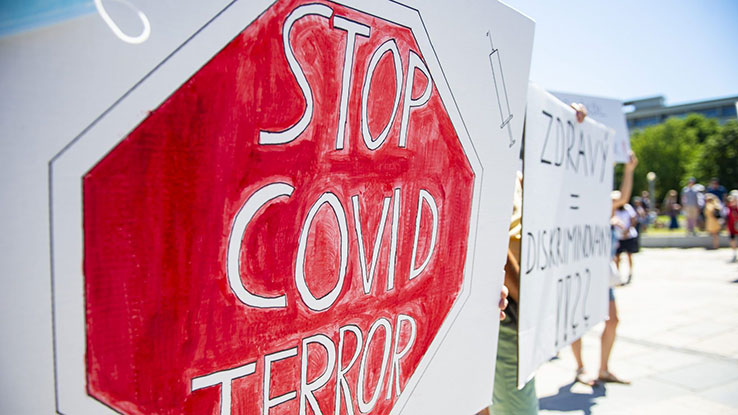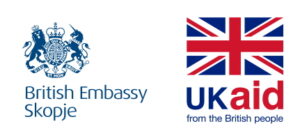Michaela Ružičková
 Despite the relatively good pandemic situation in Slovakia during the summer of 2021, the state faced an extensive anti-vaccination and anti-government campaign. It was aimed primarily against vaccination, pandemic measures and restrictions. The campaign resulted in mass protests that ended with a rally taking place on Constitution Day.
Despite the relatively good pandemic situation in Slovakia during the summer of 2021, the state faced an extensive anti-vaccination and anti-government campaign. It was aimed primarily against vaccination, pandemic measures and restrictions. The campaign resulted in mass protests that ended with a rally taking place on Constitution Day.
The anti-vaccination protest movement in Slovakia, flourishing during the summer of 2021, was based on misinterpretation of reality and the mass spread of harmful narratives. The protests were preceded by an escalation of tension and the building of an atmosphere of fear. It was supported by the spread of hoaxes, disinformation or conspiracies about Covid-19 and measures to prevent its spread. An alarming factor was the involvement of a number of actors who came not only from the notorious media with problematic content (spreading disinformation, misinformation, conspiracies or hate speech) or social networks, but also directly from politics.
At the same time, the success of the movement was amplified by the ineffective vaccination campaign run by the state. The campaign is ineffective due to the very active disinformation and conspiracy scene spreading harmful narratives against vaccination and undermining the whole process. It has also been problematic since february 2021, when the highly criticized purchase of Sputnik V vaccines without registration of the European Medicines Agency (EMA) took place. Igor Matovič, then Prime Minister, caused controversy by skipping discussions with the Ministry of Foreign Affairs about the purchase, as well as negotiating with Russia on his own. Last but not least, the state-led campaign brought the idea of “vaccination lottery” into life. That, unfortunately, met with several technical difficulties (delay in internet streaming of the show, unavailable website for participants abroad etc.) and was ridiculed in public.
It all started at the border crossings
The movement emerged on July 5, 2021, when the government's decision on stricter border controls and the closure of some border crossings in response to the re-emergence of COVID-19 infections. The very next day, the first protests came spontaneously at the border crossings of Vrbovce and Horné Sŕnie (both on Slovak side of border with Czech Republic), attended by about 200 people. Probably the biggest protest took place between the villages of Vrbovce (SK) and Velká nad Veličkou (CZ). Another key protests took place at the crossings Petržalka (SK) - Rajka (HU) and Svrčinovec (SK) - Mosty u Jablunkova (CZ) on July 9, 2021. Later on, several politicians from the political parties Republic, ĽSNS or Hlas - Social Democracy were present at the protests and shared calls for the public to join the protests.
Some politicians responded to the events, directly or indirectly supporting the protesters and spreading harmful narratives. Ľuboš Blaha, a member of SMER - Social Democracy (SMER - SD), dominated among these politicians.
Protests against scientists
In July, several protests took place in front of the homes of scientists who publicly support vaccination (infectologists Pavol Jarčuška, Vladimír Krčméry, and pediatrician Elena Prokopová). The biggest protest took place on July 14 by the house of the chief hygienist Ján Mikas.
These protests were preceded by the spread of narratives against vaccination, measures to prevent the spread of Covid-19, as well as against the above-mentioned scientists. Despite their activities aimed at increasing vaccination coverage in Slovakia, a parallel discrediting campaign against them took place. Also, the rally against the chief hygienist Ján Mikas was based on the information that he is spending a holiday abroad.
Politicians from SMER - SD and the far-right party Republika (split from the notorious far-right People's Party Our Slovakia, ĽSNS) had the largest engagement on Facebook on the given topics. The mentioned events culminated after the decision of the Constitutional Court to suspend Mikas' decree on quarantine at the borders. Milan Uhrík, chairman of Republic party, shared a post on July 13, 2021, in which he stated: We have won! The government has been slapped today (...). They are furious. And it will only get worse for them. In SMER - SD, we have turned Apartheid away for now.”
The far right is talking about totalitarianism
The cooperation of pro-national and anti-system political entities with the disinformation scene was apparent especially in connection with the organization of a protest in front of the Office of the Government of the Slovak Republic, which took place on July 10, 2021. Among the messages spread were narratives on the division of society into first- and second-class citizens (vaccinated and unvaccinated, privileged and discriminated), narratives on “apartheid”, “genocide”, human rights violations, but also attacks on government officials and academics who were reffered to as “fascists” for imposing vaccination to citizens and implementing pandemic measures.
 Source: balkaninsight.com
Source: balkaninsight.com
Further protests took place on July 23-24, 2021 in front of the Parliament and on July 29-30, 2021 in front of the Presidential Palace. The main reason for these protests was the alleged effort of the Minister of the Interior, Roman Mikulec, to amend the electoral law, which would allow the restriction of the right to vote for the non-vaccinated. The Interior Ministry called the allegation disinformation. However, Milan Uhrík spoke of the amendment to the law as “the most historically totalitarian law legalizing discrimination.”
On July 23, 2021, Milan Mazurek, another member of Republic, shared a video of his speech in Parliament in which he spoke of the government's alleged totalitarian attempt to “take people's freedom”. Also, Uhrík shared a video from a press conference of Republic, in which party members spoke of the law as “segregating” and compared it to what was happening during the Second World War.
Convergence of the far right parties and SMER-SD
An interesting aspect that we have observed in relation to the protests was the convergence of opinions and interests of far-right parties (mainly Republic, People's Party Our Slovakia ĽSNS, Slovak Revival Movement SHO, and nationalist party Slovak National Party SNS) and SMER - SD, a party that ruled almost continuously between 2006 to 2020.
SMER - SD calls itself a “social democracy”, but is better known for corruption scandals, alleged connections to the mafia, as well as conservative, populist positions. Nowadays, the party is popular mainly because of Ľuboš Blaha, who is highly active on Facebook and has been named as the “most toxic” Slovak MP. Blaha represents not only the far-left ideas, but also the spread of disinformation and hate speech. Despite the fact that it has been at the helm of three governments since 2006 and could be considered an established political entity, its new image links to an anti-system one.
 A member of SMER - SD and the “most toxic” MP, Ľuboš Blaha (left), meeting the chairman of the far-right ĽSNS party, Marian Kotleba (right), on the protest on July 23, 2021. Photo: TASR (Source: Denník N).
A member of SMER - SD and the “most toxic” MP, Ľuboš Blaha (left), meeting the chairman of the far-right ĽSNS party, Marian Kotleba (right), on the protest on July 23, 2021. Photo: TASR (Source: Denník N).
ĽSNS directly invited people to participate in these protests, while SMER - SD did not call for protests, despite of the fact, that its members took part as speakers. From the rally on July 23, 2021 comes the infamous photograph of the meeting of Ľ. Blaha and M. Kotleba. It has become a symbol of the convergence of the Slovak far-right and far-left (shown by the horseshoe-shaped political spectrum).
After the “enthusiasm” for the protests subsided, SMER - SD began to focus on the announced protest on September 1, which was to take place in front of the Constitutional Court building in Košice.
August protests without Ľuboš Blaha
Further massive protests took place on August 5-7, 2021 in front of the Office of the Government of the Slovak Republic and the Presidential Palace. Unlike in the previous protests, Ľuboš Blaha did not take part in it. He announced on August 1 that he needs to “switch off politics”. There was also a lack of activity from SMER - SD chairman, Robert Fico, as well as Republic, which distanced itself from these protests. This led to the full involvement of far right People's Party Our Slovakia ĽSNS and its chairman Marian Kotleba.
Several key moments emerged: the call of Marian Kotleba to the protests, the detention of Kotleba's brother and MP, Marek Kotleba, and the presence of the police. The rhetoric of “resistance to totalitarian measures” and liquidation of rights was strongly present. In addition to participating in the protests, Kotleba called for the need for a “blockade of Bratislava”, which he considers an effective tool in the nation's struggle for “freedom in vaccination”. In the video, he answered the “tactical questions” of the protest organization, when he talked about the use of “heavy equipment”.
Therefore, ĽSNS was the most active party in the organization of protests. Marian Kotleba even sought to personify these protests. To achieve this goal, he was supported by a wide network of his “allies” on social media (websites, individuals/bloggers, fan pages, members of ĽSNS).
Constitution Day
The last protests took place on the Constitution Day of the Slovak Republic (September 1) in Bratislava and Košice, in front of the building of the Constitutional Court. The protests in Košice were attended by approximately 6,000 people in two main rallies organized by Republic and by SMER - SD. These protests were calmer and ended sooner than the parallel rallies in Bratislava, where participants blocked traffic and got into skirmishes with the police. There were only two minor incidents in Košice, when police intervened.
According to Peter Dubóczi, an analyst for the website Infosecurity.sk, “a form of symbiosis between pro-national and anti-system political actors has emerged in the beginning, with the disinformation scene amplifying their calls to block borders”. Later on, we have witnessed the strong ability of these actors to act jointly with problematic online media to fight against a system personified by the government and the parliamentary coalition. It is at least paradoxical that these parties and individuals with an inclination to the far-right and far-left, issued support for the protests for so-called “protection of democracy”.
The strong links between problematic online media and mentioned political parties was observed during the protests. At the same time, we have witnessed some kind of symbiosis between several mentioned political parties - despite different agendas or ideological perception. The strongest pillar of the whole protest movement until September 1, 2021, were the activities of SMER - SD. Despite its long political history and its three governmental periods, this well established party was acting against the system, the government, and state institutions, whose authority may be thus partly undermined. Acting together with other mentioned parties as Republic or ĽSNS, made the whole summer a very dangerous season for Slovak democracy.
The anti-government protests represent the result of long-existing polarisation of society, which is fueled by the disinformation and conspiracies spread by problematic online media. The future will, therefore, be determined by another eventual trigger to restart the protest movement, or, on the other hand, by a successful state-led fight against disinformation.
Please refer to the Terms before commenting and republishing the content.
Note: The views and opinions expressed in this article are those of the author and do not necessarily reflect the views of the Institute of Communication Studies or the donor.


